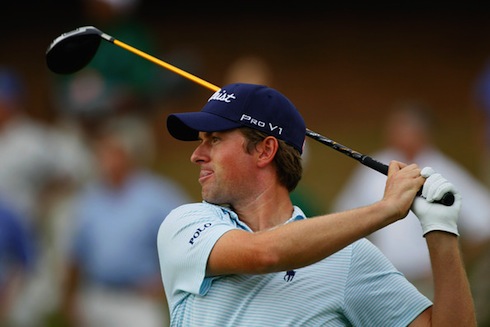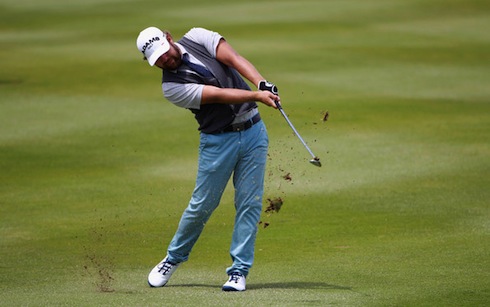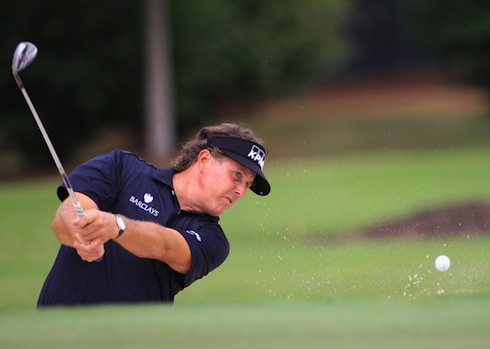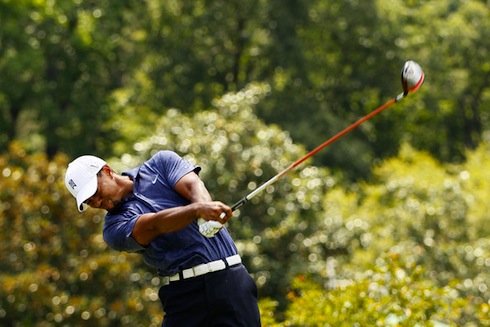 Parity is the name of the game in sports these days. Many leagues do everything they possibly can to make sure that any team can do well any year. The NFL, in particular, prides itself on this.
Parity is the name of the game in sports these days. Many leagues do everything they possibly can to make sure that any team can do well any year. The NFL, in particular, prides itself on this.
Thanks to aggressive revenue sharing, a hard salary cap, the importance of drafting, and the nature of a 16-game schedule, the NFL is set up so that a team like the Kansas City Chiefs can go 4-12 one year (2009), hire a few new coordinators, and finish 10-6 the next year to win their division. By that same token, a team like the Minnesota Vikings can go 12-4 in 2009 and then 6-10 in 2010.
Golf has none of that. It’s an individual sport, so there is no regulation to spread out the finishes. Each player effectively controls his own destiny. If there is to be parity in golf, it has to come about because of the players, not because of the PGA Tour.
That’s the problem golf is facing now. With a wealth of relatively equally-spaced talent, the PGA Tour is becoming increasingly, well, boring. Without a few polarizing superstars, dynasties, if you will, many of the golf tournaments this year have been downright bland. And, at least in near future, it’s only going to get worse.
Number Five: The Media
The media drives golf. Merchandise sales and attendance at tournaments play a role, but a bulk of the money comes from television deals. It stands to reason that the more people talk about golf, the more they watch golf. If someone sees a lot of golf analysis on ESPN or in the newspapers, not only will they be better fans, but they’ll watch the actual tournaments.

Webb Simpson doesn’t make the front page of the New York Times when he wins, probably not even if he were to major, unless he runs away with it like Rory did. Tiger would. Phil probably would. Tom Watson definitely would. But aside from that, golf isn’t going to get a lot of big-time notoriety, and that’s only going to get worse with parity. Without superstars, The PGA Tour has no one that makes their product pop.
Number Four: None of the Downsides
Golf in the 21st century is always going to have depth. The 50th-best player today is light-years ahead of the 50th-best player from the 1970s, not to mention the 1940s. As the game grows overseas, as Asia, Africa, and Australia catch up to Europe and American, the game is only going to get more deep.
To pull a metaphor from baseball, golf is a team that has four middle relievers that could be a closer on every other team. It’s like golf has Brandon League, Leo Nunez, Huston Street, Sergio Santos, and Carlos Marmol all on one team, but none of them are Trevor Hoffman or Mariano Rivera. Where golf used to have one guy holding down the end of games, it’s now closer-by-committee.
Unfortunately, as the 2003 Boston Red Sox proved, closer-by-committee doesn’t work. You need one guy who is going to come into the game, strike fear in the hitters, and blow them away with high heat.
That’s where the metaphor ends though. Because golf is growing worldwide, expending depth is inevitable. Golf will never have Jonathon Papelbon at closer along with a bunch of no-names because the game is way too deep. In non-baseball terms, non-parity in golf has none of the downside that most other sports face.
Because of the massive, albeit annoyingly spread-out, talent pool in golf, it’s not going to be a superstar and bunch of guys who can’t play. It’s going to be a bunch of guys who can play pretty well. We’re still going to have guys with nice stories. Gary Woodland, Y.E. Yang, and Camilo Villegas won’t go away, but the PGA Tour doesn’t have to base its advertising on the goofy wardrobe of Ryan Moore or the funky swing of Tommy Gainey. These guys can play second-fiddle, and play it well, as we saw throughout the last decade, and the PGA Tour could flourish, but without a handful of bona-fide superstars heading up the marketing, the PGA Tour’s product looks incomplete. It needs a few all-time great at the top, followed by a gigantic amount of well above-average guys bringing up the rear. Because golf with parity is basically that circumstance minus the superstars, there is no downside. Those top players aren’t going to win every major, they won’t play every tournament, and that’s where the Tour can show its depth.

Number Three: No Greatness in Scrubs
Golf and its popularity have long been defined by its best players. The Great Triumvirate dominated the early 1900s. Bobby Jones returned to a ticker-tape parade in Atlanta after winning all four majors in one year. Ben Hogan bounced back from a horrid car accident better than ever. Arnold Palmer transcended the golf world, and was able to move into mainstream ads and iced-tea (which is probably what most 20-year-olds know him for best these days). Fat Jack shed a few pounds and impressed everyone with his massive length and unmatched drive to win. And Tiger Woods fist-pumped his way in and out of the hearts of the elusive “casual fans.”
Eras in golf have always had a dominant player or two, with a few Mickelson/Trevino/Dameret types filling it out. Aside from that, the fields were pretty limited. The stars couldn’t win every event, but they were so big that the main stories were always about them losing rather than the no-name guy who actually pulled it out. Parity might spare you the occasional Shaun Micheel, but it will mean a lot of guys like Lucas Glover winning. Guys who will show up every now and then, make some noise, then settle with 40th on the money list. No one is going to be there every time, and no one is going to light it up. That’s bad for golf.

Number Two: Outliers Drive the Sport
People like rooting for outliers. Fans love Phil’s go-for-broke style, his stellar short game, and his massive length off the tee and overlooked his horrid driving accuracy and shaky putting. Jack Nicklaus and Arnold Palmer were both historically long, despite not being great around the greens, and Ben Hogan was one of the best ball-strikers of all time. Tiger Woods was simply good at everything. One of the Tour’s longest hitters, it’s best ball-striker, and probably golf best clutch putter of all time, he was an outlier in every category.
Without superstars, golf has none of that. Everyone is a long hitter now, so no one stands out. Not only are there no players who transcend several categories like Tiger and Phil did, no one runs away with anything either. Yes, Steve Striker is among the leaders in putting and scrambling, but he has to be, because he’s T116 in driving distance, 60th in driving accuracy, and 50th in ballstriking. He needs to putt well or he’d never contend. Jason Day is another guy who is among the leaders in several categories (putting, driving distance, scrambling), but again, he has to be. He’s monumentally terrible in driving accuracy, and he’s a well below-average ballstriker.
Contrast that to Tiger’s 2005 season, where he was ninth in strokes gained- putting, second in driving distance, sixth in GIR, and 14th in scrambling, a category he’s won three times.
Number One: Golf isn’t Football
Parity improves most sports. It’s simple. In team sports, people almost always pick one team to root for, usually based on geographical location. But fans won’t watch a crappy team limp to a sub-.500 record, no matter the team’s history. Just ask the Los Angeles Dodgers. But (and especially with football), people will watch their team as long as they aren’t in the very depths of futility. As long as a team stays viable, as long as it’s not painful to watch, people are going to tune in, because in most sports, anyone can win any game. Even the Brown beat the 14-2 Patriots last year.
Golf fans are different, they don’t pick favorite player based on where they live. They pick them for star power, how exciting they are, their back-story, or if they like their swing. Therein lies the problem.

Because of this, fandom is fleeting. When Tiger was away with his knee injury in 2008, I became a huge Vijay Singh fan. As well as he played, especially in the FedExCup, it was hard not to. I liked the stories of how Vijay was the hardest worker out there despite begin over 40, how he tried every swing aid on the market, how he learned the game hitting coconuts. (Of course, I overlooked the mid-1980s scorecard doctoring, proving the irrationality of sports-fandom.) The way I rooted for Vijay was different from the way I root for the Red Sox though. As a primary Tiger fan, Vijay was a placeholder. I wouldn’t take up rooting for the Yankees just because the Red Sox slip out of the playoff race. Just as fast as Vijay snuck his way into my golf viewing schedule, he left. Nowadays, I hardly even take note of Vijay’s appearances on the Tour.
I picked Vijay because I like his story. There are only maybe a couple dozen such golfers on Tour ever year that people really, truly root for, which means that nobody cares about the vast majority of PGA Tour golfers. Brandon Jobe, despite making over $1.5 million this year, doesn’t fill up the grandstands when he’s in the mix on Sunday. Neither does Cameron Triangle, or Mark Wilson, or Chris Kirk.
Because of this, most people only watch golf when their guys are in the mix. For me that’s Tiger, Matt Kuchar, Adam Scott, Rickie Fowler, Sergio Gacia, Keegan Bradley, and Jim Furyk, among a few others. As a hardcore golf fan, that list is probably longer than most people, in fact, I’d be willing to guess most of the people that tuned in throughout the 2000s were there to watch two guys: Tiger Woods and Phil Mickelson.
Again, golf isn’t football. Football teams play just about every single Sunday throughout the season, and most people make it a point to park themselves in front of a television. You know you are going to watch going in, you can schedule around football. But with golf, there’s a decent chance that you could tune in on Sunday to a leaderboard of George McNeil, Kyle Stanley, Joe CountryClub, and Mark TaylorMade. People don’t tune in to watch those guys gut out pars on a golf course they know Tiger Woods or Phil Mickelson could have torched in 2007, because in golf, people tune in for the people, not for the game. And without superstars, people aren’t going to tune in at all.
Closing and Your Thoughts?
Obviously, no one wants to watch just one superstar player and a bunch of srubs. I’m not arguing that. But a world of golf without any superstar players is going to be just as bad. Superstars drive ratings, viewership, and money, and while it might be nice to not know who is going to win week in and week out, it’s not nice when people aren’t even familiar with the winners.
These guys might be good, but one superstar is much greater.
Photo Credits: © Andrew Redington, © Kevin C. Cox, © Sam Greenwood, © Kevin C. Cox.

*Tommy Gainey
It’s yet to be seen if golf today is lacking a superstar or if it has numerous superstars. Tigers self destruction came at the same time some very good young players started to play to the level that was expected from them.
Golf and these young golfers are in a bit of a no win situation because if Tiger comes back and doesn’t dominate he’ll have the built in excuse of his injuries and personal problems and these guys will never get the accolades they deserve. Could Tiger at his best beat these guys at their best? We may never get the answer to the question.
Really golf isn’t football? I had no idea! Sorry normally :’m a fan but this entry is just plain bad.
Parity for golf blows because sports everywhere is all about favorites and underdogs and without a favorite in the first place their can by definition be no underdog and therefore no drama and sports without drama is boring.
History tends to repeat itself.
1920-1930 Bobby Jones and Walter Hagen dominated with Sarazen doing really well
*1930-1945* no one dominated Nelson was close *WWII brings the sporting world to a halt.
1945-1954 Hogan dominated with Snead nearly equal
1954-1960 no one dominated
1960-1962 Arnold Palmer dominates
1962-1975 Jack truly dominates with Player, Casper, Palmer (early) and Trevino (late) as his closest competition
1976 parity
1977-1983 Tom Watson dominates
1984-1997 parity. Norman and Faldo have great careers
1997-2007 Woods dominates
2008-current no one dominates
Over the last 90 years, the average length of parity is nine years.
I disagree. I watch golf more now that the field has parity. I got tired of seeing Tiger win time and time again. Now it is exciting to see who is going to come out on top each week. The “young guns” bring a whole new feel to the game of golf. They bring some flair and variety into the game where before it was the same old ‘stuffed shirts’ walking the track. In my opinion the game has more appeal now with the Europeans, the next wave of American kids and a sprinkle of some international upstarts trying to make it through a Sunday round.
You make some interesting comments, but I find what you term as parity to make much more interesting viewing. I don’t miss the in-your-face fist pumps and the other generally rude behavior of Woods at all. When all the sycophants who are intersted more in celebrities than golf are truly weeded out, watching golf will again be enjoyable for serious golfers.
Parity is more a function of the USGA and the R&A. Given modern equipment, training, coaching, etc., it is leveling the field. I think that we will see a new generation of stars emerging from the President’s and Ryder Cup teams along with the majors. I find good golf compelling and don’t watch because of star power although I will concede that a lack of a field is not as interesting as having some recognizable talent.
while i didnt care for tiger during his struggles, i wouldn’t seeing him win. It IS VERY sad however when you constantly hear the question/percentage chance that tiger has to catch or surpass jack’s majors total. and on golf channel, its always at least “50%” which i think is actually TOO high. Parity has done much more for golf now because it has brought about successful rookies all year, former college rivals, and better competition knowing that tiger is at his all-time worst. There has also been numerous players from japan and even korea that have shown promise.
I think parity is necessary for golf because then the game won’t get stagnant, new tour pros will actually have a chance, and eventually all this will lead to a new dominating player in the world. I feel most people (people in the US) don’t like parity because then that means the US isn’t dominating anymore (tiger/phil era). if you feel that way, then shame shame. this game is global and becoming more exciting. and if you don’t care for that, im sorry, but you don’t really have a true passion for this great game.
I agree! Golf is much more interesting to watch, for me at least, when there is a dominant player. I would’ve never believed it 2 years ago but I have not watched more than 2 hours of ‘non-major’ golf this year.
Jamo,
I understand where you’re coming from, but I disagree with a couple of points.
THE MEDIA… The media wants a superstar each year so its job is easier. Media studies show that non-golfers will watch TV golf more when a “star” is on a hot streak. A few months ago, someone wrote on a TST post that he was tired of “no-names” winning major tournaments. If someone wins a major, he’s no longer a no-name.
Big changes took hole in the 1990s: An explosion came in golf club variety and many golfers started training like athletes. Big, strong golfers no longer needed to play with clubs designed for Mr. USA, a guy who is 5-foot-9 tall. This has leveled the playing field. Tiger Woods was the prototype for the 21st Century golfer… But, while Tiger got sidelines with marital and knee problems, a dozen golfers of the Tiger 2.0 model have arrived on the scene.
So, the poor media bunnies will have to actually know something about golf, and do more than sell high-priced advertising spots. They’ll have to – OMIGOSH! – do their job…
YOUR LAST LINE…
Sorry, Jamo, but the golf fans will have to know something about the sport atoo. In the 21st Century, superstar is a moving target.
Does golf need a superstar, or 2 or 3, to drive up interest in the game, increase TV Ratings, attract more sponsors, etc… obviously the answer is yes. Phil Mickelson during an interview with PBS’s Charlie Rose following this years British Open, stated he, Phil Mickelson, was probably the biggest beneficiary among pro’s of the “Tiger Effect” with respect to his own endorsement deals, increased tournament prize money, etc., etc. Phil has openly stated golf needs Tiger back. (Toothless or not!)
Does golf need superstars to continue to just succeed and continue to exist as a televised professional sport… probably not, as history has shown. But any sport, golf included, is a much more compelling event of interest to both avid and casual fan alike when there’s a clash of immense talents to see who can summon up the will and courage to produce those shots that make one gasp with amazement and awe. Superstars, by definition, can do this more often than others, and we as fans sit on the edge of our seats to see if they can do it again. I mean let’s face it, the primary dramatic edge to the FedEx Tour Championship was Webb Simpson’s collapse, and chalkboard tracking of the mathematical point scoring permutations allowing Hunter and Hass to get into a playoff, decided by a wonderful recovery shot out of the water. Fortunately for the tour, Very Good but not quite great drama in my book, as I fell asleep half way thru the back 9, but hey that’s just me!
I recall articles in Golf Digest and Sports Illustrated lamenting the vanilla plainess of golf after Jack Nicklaus retired. Yet we still had great golfers like Seve, Sir Nick, Greg, Davis, Ben, Freddie, Tom Kite, etc.
OK… all of you reading this know who the great golfers are I just named. Who else in your family or circle of non-golf friends would know more than 1 or 2 by their 1st name? Mention “Tiger” and I’ll bet virtually all do, and not necessarily just because of his run in with a fire hydrant.
Tiger was, and may still be, a supernova the likes of which we may not see for a long long time, especially with the depths of talent worldwide making the likelihood of dominance that much more difficult.
Superstars like Tiger and Phil, play golf that compells one to want to watch them play, hardcore fan or not. It doesn’t even matter if either is playing well or not, or if you are even rooting for them. Rory, and maybe Rickey & Keeghan, have shown this year they might eventually belong in this category, at least to me. As avid golfers, we can appreciate the difficulty of the game, a particular shot, and the immense talent displayed by all pro level golfers, no matter the tournament. But these factors aren’t always so apparent to the average sports fan, especially those who have never played the game. Superstars can transcend these limitations, immerse us with the drama of their performance, and inspire the casual fan to give golf a try for themselves.
So here’s one avid fan’s encouragement to golf’s current 2 superstars to find their games in 2012, and do battle with the up and coming stars head to head.
Oh, I also hope the Putting Fairy blesses Phil, Ernie, Vijay and Furyk with some pixie dust, so they can put those broomhandles to good use!